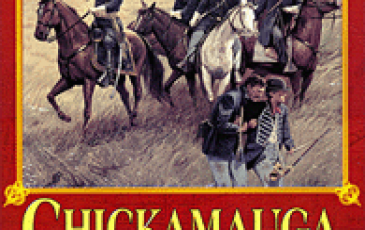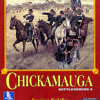26 Dec 61, Chustenalah, IndTer - Battleground 9: Chickamauga

| Rating: | 0 (0) |
| Games Played: | 0 |
| SM: | 3 |
| Turns: | 13 |
| Type: | Custom |
| First Side: | CSA |
| Second Side: | Union |
| Downloads: | 34 |
26 December 1861, Chustenalah, IndTer [Curt Cabbage]
During the Civil War in Indian Territory Chustenahlah was the decisive battle of the Confederate pursuit of Creek Chief Opothleyahola. In November 1861 Indian Territory commander Col. Douglas H. Cooper set out to subdue Opothleyahola's followers, who disputed the Creek and Seminole alliances with the Confederate States of America. Perhaps seventeen hundred refugees, many of whom were women and children, were with Opothleyahola following his defeat at Chusto-Talasah on December 9. The loss of horses and supplies and the arrival of ice forced Opothleyahola's band to halt before it could reach the safety of Kansas. The members found shelter beside Shoal Creek (now Battle Creek, near Skiatook in Osage County) in what is now called the Patriot Hills. Cooper directed that two resupplied and reinforced Confederate columns converge on the refugees. On December 26, however, Col. James McIntosh's force attacked alone immediately upon locating Opothleyahola's camp. Opothleyahola's men retreated slowly up a sheer, brushy hillside to purchase time for their families to escape. After four hours of close fighting McIntosh's Texas and Arkansas troops routed the defenders. McIntosh reported forty-nine Confederate casualties at this "Battle of Chustenahlah" and over 250 Indian casualties, besides many women and children captured. Unknown hundreds of the pursued died from gunshots, starvation, and exposure during the campaign. Yet, many male survivors returned with three U.S. Indian Home Guard regiments to again fight in Indian Territory.
During the Civil War in Indian Territory Chustenahlah was the decisive battle of the Confederate pursuit of Creek Chief Opothleyahola. In November 1861 Indian Territory commander Col. Douglas H. Cooper set out to subdue Opothleyahola's followers, who disputed the Creek and Seminole alliances with the Confederate States of America. Perhaps seventeen hundred refugees, many of whom were women and children, were with Opothleyahola following his defeat at Chusto-Talasah on December 9. The loss of horses and supplies and the arrival of ice forced Opothleyahola's band to halt before it could reach the safety of Kansas. The members found shelter beside Shoal Creek (now Battle Creek, near Skiatook in Osage County) in what is now called the Patriot Hills. Cooper directed that two resupplied and reinforced Confederate columns converge on the refugees. On December 26, however, Col. James McIntosh's force attacked alone immediately upon locating Opothleyahola's camp. Opothleyahola's men retreated slowly up a sheer, brushy hillside to purchase time for their families to escape. After four hours of close fighting McIntosh's Texas and Arkansas troops routed the defenders. McIntosh reported forty-nine Confederate casualties at this "Battle of Chustenahlah" and over 250 Indian casualties, besides many women and children captured. Unknown hundreds of the pursued died from gunshots, starvation, and exposure during the campaign. Yet, many male survivors returned with three U.S. Indian Home Guard regiments to again fight in Indian Territory.























